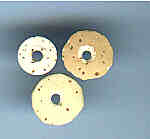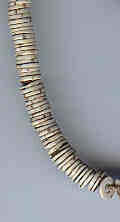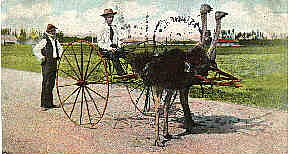The Bead Site =Home>Beadmaking & Materials>Organic> Ostrich Eggshell
|
|
Big Bird, Dinosaurs and Beads
The question of the oldest beads is still in dispute (see this page), but the oldest ones in Africa are of ostrich eggshell found in the Enkapune Ya Muto rock shelter in the Rift Valley of Kenya. They have been dated to 37,000 to 39,900 years ago. Thirteen complete beads, twelve preforms and 593 shell fragments were found. It is clear from the illustrations that each bead was made individually, not by the heishi technique (see below).
The excavator, Stanley Ambrose of the University of Illinois at Urbana, has pointed out the vital cultural meaning of beads to the !Kung San (once called "Bushmen"). He believes the earliest beads could have played a similar role:
One may further speculate that if ostrich eggshell beads reflect an enhanced symbolic system of socially mediated risk-minimization and social solidarity, this may have facilitated population increase in Africa, the spread of modern humans out of Africa and the replacement of archaic human populations in Eurasia.
What a lot of responsibility for a little bead!
|
Ostrich eggshell beads are also among the oldest beads in India and China, where, on some occasions, dinosaur eggshell was substituted. Indians some 20,000 years ago may have pioneered the beadmaking technique now called the "heishi process."
"Heishi" derives from the Santo Domingo Pueblo of New Mexico and means "shell bead." As a stand-alone, the word should only be used for beads made by these artisans. It has been adopted to refer to the technique or process by which similar beads are made and has a global distribution.
|
Ostriches are the biggest living bird. They walk on two legs, but cannot fly. We think of them as African, but in the past their range was much wider. They were still living in Persia in the 14th century and Arabia in the early 20th.
Ostriches are clever and hard to catch. They run very fast and their kick is strong enough to kill a man or even a horse. It was hard for early people to catch ostriches, but their eggs were more available. They are about the size of 40 chicken eggs. To steal one from an ostrich nest, just throw a rock into the weeds. Ostriches are curious and will leave the nest to see what is going on.
And what a steal! I have not eaten an ostrich omelet, but many people say they are very tasty. If you empty the egg from a hole you can use the shell to hold water (before people had bottles or pots). And when the eggshell breaks, you can make beads from them.
__________________________________________________
Small Bead Businesses | Beading & Beadwork | Ancient Beads | Trade Beads
Beadmaking & Materials | Bead Uses | Researching Beads | Beads and People
Center for Bead Research | Book Store | Free Store | Bead Bazaar
Shopping Mall | The Bead Auction | Galleries | People | Events
The Bead Site Home | Chat Line | Contact Us | Site Search Engine | FAQ



